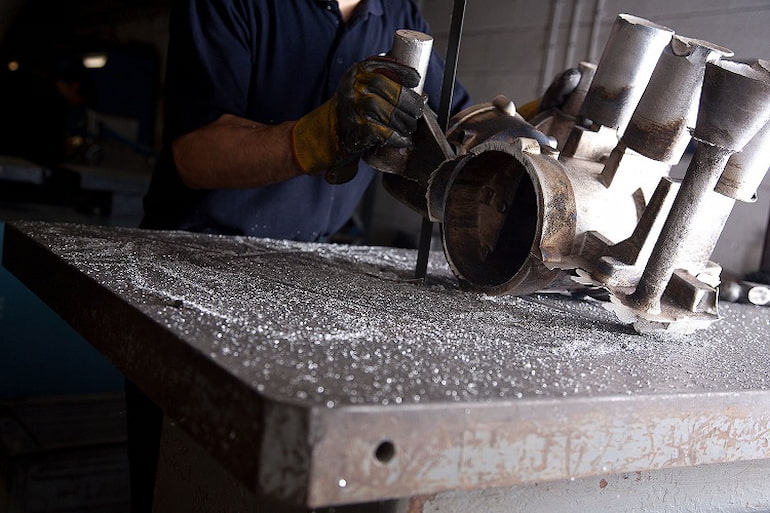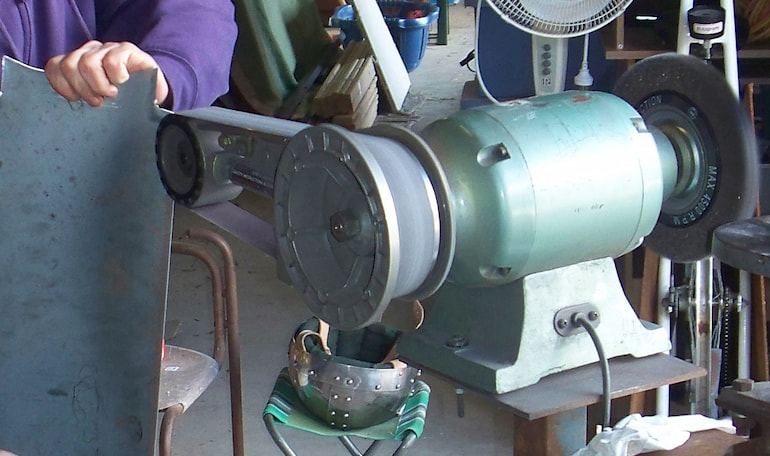Linishing is a metalworking process similar to sanding and grinding, with the end goal of getting smooth and flat metal surfaces. Instead of a grinder and attached sanding disc, the process involves a linishing machine that spins an abrasive belt around two or more rollers. It is this belt that smooths and flattens the workpiece, until it is ready for further processing, such as electroplating or polishing.
The procedure is common in both small commercial and large industrial businesses that involve welding, tool machining, the manufacture of automotive and aerospace components, pipes, bike frames, electronics, furniture and more. Linishing is also found in general repair work when dealing with rough metals, removing rust or previous signs of machining. The process differs from general finishing methods such as grinding and sanding in that workpieces are usually worked in multiple planes, so smoothing, cleaning and stock removal are more controlled and lead to a finer finish. Materials that are worked include unalloyed steels, stainless steel and aluminium, as well as a long list of other ferrous and non-ferrous metals and alloys.

How is Linishing Done?
Workpieces are ground against an abrasive linishing belt wound tight across rollers or drums. The machine spins the belt and friction between the workpiece and belt removes surface imperfections. The end result differs according to the grain or material used in the belt, the coarseness or grit of the abrasive it is lined with, the applied pressure to the workpiece, and the specifics of the linishing machine, specifically the RPMs it can achieve. Most work is carried out on manual machines, or simply linishers, but automated machines reduce labour requirements, improve employee safety, and produce smooth, flat metals consistently and at a faster rate.
Why Have Metals Linished?
Metals need to be processed, before end-finishing processes, such as powder coating, anodising, galvanisation and electroplating take place. This is a preparatory phase that removes burrs and rough edges and leads to a more pleasing look. Besides this, linishing is necessary to remove unwanted texture in the metal grain, as well as surface blemishes like corrosion. This additionally helps with durability and reduces the likelihood of wear.
Another reason why metals are linished is to get the required dimensions. Belts remove minute quantities with each pass, so more precision and tighter tolerances can be achieved compared to grinding or sanding. The process is also versatile, so can be carried out on most common metals and alloys. A key factor in the end result is choosing a linishing belt that is appropriate for the workpiece.

Types of Linishing Belts
There are four major types of belts according to the grain or abrasive material.
Aluminium Oxide Belts
These are the least expensive and most common belts used with linishers. They’re recognisable by their distinct reddish-brown colour and can be found in all jobs where steel, steel alloys and aluminium are widely used. They have a string backing material that lends them good strength. Aluminium oxide belts are a good general-purpose tool used in everyday sanding, grinding, deburring and blending tasks.
Zirconia
Belts with a zirconia abrasive grain are up to five times stronger than aluminium oxide, so can be seen in high-pressure applications. Part of their strength is down to the self-sharpening material, meaning faster cuts and more consistent results over a longer period. They’re ideal for abrasive planing, sanding, deburring, grinding and finishing jobs in cast iron, tool steel, stainless steel and harder metals like tungsten and titanium. You’ll find them in blue.
Ceramic Belts
If you need a belt that lasts the longest and is used on metals that are heat-sensitive, then nothing beats ceramic belts. They have a very strong backing material that makes them durable, and their self-sharpening abrasive is razor-sharp for clean, consistent results. A major benefit is that they run cool no matter the linisher speed and prevent metal contamination. Ideal uses are with stainless steel, nickel and cobalt and their alloys. Get them in an abrasive red.
Silicon Carbide
This is a belt with an extremely sharp abrasive used in low-pressure jobs needing a smooth, uniform finish. The grain is ideal for fast removal of surface contaminants, such as rust and flaking paint, as well as most finishing and polishing tasks in metals like titanium, aluminium, bronze and brass. One downside is that while sharp, the abrasive is also brittle, so you’ll be changing these out more than other belts. Get them in black.

Choosing Belts in the Right Grit
Grit refers to how smooth or coarse the belt abrasive is and directly determines how much material is removed, as well as speed and the end finish. Choose the belt grit according to the job. For general stock removal, coarser grit between 24 and 60 is preferred. Smoothing out smaller imperfections is done with belts in medium 80 to 120 grit while polishing and finishing tasks require very smooth belts with grit between 200 and 400.
Another consideration is getting belts that fit the linisher. Look for the appropriate widths (ranging from an extra thin 50mm to very wide 500mm belts) and lengths between 400 and 2000mm. Prices naturally depend on grain, grit and overall size.

